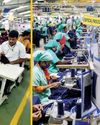Self-reliance in the defence sector has been a long cherished goal of the Indian policymakers.

Efforts have been undertaken in this regard but India still imports a sizeable amount of military hardware from other economies. The spiralling defence budget can largely be attributed to these imported military equipment and hardware. However, India is trying to reduce its military dependency. According to the Draft of Defence Production Policy, 2018, Indian indigenous defence production increased from 43,746 crore in 2013-2014 to 55,894 crore in 2016-2017. According to the Draft of Defence Production Policy, “India is aiming to achieve a turnover of 1,70,000 crore in defence goods and services, involving additional investment of nearly 70,000 crore and to achieve export of 35,000 crore in defence goods and services by 2025.”
The Defence Research and Development Organisation (DRDO) recently established and developed around 52 defence labs to strengthen research in defence. The Hindustan Aeronautics Limited (HAL) has been promoting and undertaking research in defence aeronautics whereas the Mazagdon Dock Shipbuilders Ltd. (MDL), Garden Reach Shipbuilders and Engineers (GRSE) have been pioneering research in maritime defence. The Bharat Dynamics Ltd. (BDL) and the Bharat Earth Movers Ltd. (BEML) have been pioneering research for the army.
Currently, India has the fifth largest defence budget in the world as it obtains 60% of its weapon systems from the foreign market. The Indian government is focusing on strategic tie-ups for enhancing self-dependence in the defence sector. The Chapter-VII of Defence Procurement Procedure (DPP), 2016, includes a chapter on ‘Revitalising Defence Industrial Ecosystem through Strategic Partnerships’.
Denne historien er fra October 16 - 31, 2018-utgaven av BUSINESS ECONOMICS.
Start din 7-dagers gratis prøveperiode på Magzter GOLD for å få tilgang til tusenvis av utvalgte premiumhistorier og 9000+ magasiner og aviser.
Allerede abonnent ? Logg på
Denne historien er fra October 16 - 31, 2018-utgaven av BUSINESS ECONOMICS.
Start din 7-dagers gratis prøveperiode på Magzter GOLD for å få tilgang til tusenvis av utvalgte premiumhistorier og 9000+ magasiner og aviser.
Allerede abonnent? Logg på

Bank of Baroda, Kolkata Zone organised Mega Kisan Melas in West Bengal
Bank of Baroda (BOB) organised Mega Kisan Mela at Konkalitala in Birbhum District of West Bengal on November 18, 2024 as a part of the 7th Edition of the Baroda Kisan Pakhwada (BKP).

Time-Bound Disposal of Cases to Expedite the Delivery of Justice and affordabe by all in India
The delay in the disposal of cases in Indian courts remains a significant hurdle to the nation's progress.

Dev Deepawali: A grand celebration of light, spirituality, and culture in Varanasi
The holy city of Varanasi, often regarded as India's spiritual and cultural heart, came alive with the splendor of Dev Deepawali on the sacred day of Kartik Purnima.

The life of Job 'Ye judge not the judgment of God' - Jesus Christ
The Holy Bible reveals through the life of Job how the Lord tests the righteous and that faith helps one to overcome life's adversities.

India has the highest potential for the garment industry, only a conducive government policy is required.
India's textile industry is poised for remarkable growth, with expectations to double its contribution to the GDP within the next six to seven years.

Global Public Debt may be worse than it appears, warns IMF
Global Public Debt Set to Exceed $100 Trillion, Warns IMF

The economic consequences of Trump's Presidency: A global perspective
One of the key economic factors contributing to the Democrats' loss in the US elections was the significant rise in inflation, which was initially triggered by the COVID-19 pandemic and exacerbated by the Russia-Ukraine war.

Challenges and Successes in West Bengal's Education Sector: A Comprehensive Overview
The education system in West Bengal, particularly in districts, villages, slums, and government institutions, reflects a blend of progress and ongoing challenges.

What India can expect from Trump's return
I may be too early to predict how Donald Trump's second term as president will impact the global oil market.

Stocks Surge Following Donald Trump's Election as 47th President of the USA
Stocks soared following the election of Donald Trump as the 47th President of the United States. Investors anticipated that the Information Technology (IT) sector would benefit from lower corporate taxes under the Republican regime, with IT stocks leading the rally.